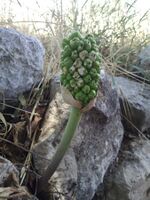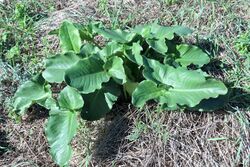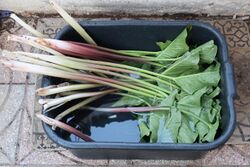Biology:Arum palaestinum
| Arum palaestinum | |
|---|---|

| |
| Scientific classification | |
| Kingdom: | Plantae |
| Clade: | Tracheophytes |
| Clade: | Angiosperms |
| Clade: | Monocots |
| Order: | Alismatales |
| Family: | Araceae |
| Genus: | Arum |
| Species: | A. palaestinum
|
| Binomial name | |
| Arum palaestinum Boiss. (1854)
| |
| Synonyms[1] | |
| |
Arum palaestinum is a species of flowering herbaceous perennial plant in the family Araceae and the genus Arum (also known as black calla, Solomon's lily, priest's hood, noo'ah loof and kardi)[2] It is native to the Levant and other parts of the Mediterranean Basin, and has been naturalized in North America, North Africa, Europe, Western Asia, and Australia[1][3][4] The family Araceae includes other well-known plants such as Anthurium, Caladium, and Philodendron.
Arum palaestinum is perhaps best known for it long history in the Middle East as food and for it use in traditional Middle Eastern medicine.
Description
It grows 10–25 cm (0.33–0.82 ft) high. It blooms in the spring, between the months of March and April, by which time the plant is easily recognized by its dark purplish-black spadix enclosed by a reddish-brown spathe.[5][6] It is a perennial plant. The leaves of A. palaestinum are light green, narrow, and upright with a purplish-black color. The root is tuberous.[7]
Like other members of the genus Arum, this plant gives off a scent that attracts flies, which distribute the pollen; while most other family members smell like dung and carrion, this plant can smell like rotting fruit as well.[8][9]
Its Latin name is derived from Palestine, and it is native to the Levant and other parts of the Mediterranean Basin, and has been naturalized in North America, North Africa, Europe, Western Asia, and Australia.[1]
Toxicity
Arum palaestinum is toxic at low doses, and this has traditionally been considered to be due to oxalate salts,[7] but this is not certain.[10] The leaves of the plant contain calcium oxalate and other toxins that are removable by leaching.
The symptoms caused by exposure to the raw plant include mucous membrane irritation, and burning, and consuming larger doses causes nausea, diarrhea, and cramping.[10] Because exposure to skin can cause irritation it is often handled lightly, or with gloves.[11]
History
Engraved drawings of various species of Arum are seen in the Temple of Thutmose III in Karnak (Egypt), depicting the plants when they were brought from Canaan in the year 1447 BCE.[7] The plant is mentioned in the Mishnah, where its cultivation and use as food was described.[7][12]
Theophrastus' Enquiry into Plants, described the necessity of leaching the roots and leaves before they can be eaten.[13]
The 11th-century Mishnaic exegete Nathan ben Abraham describes the cultivation of the plant in the Levant:
'If arum is covered up with earth in the Seventh Year' (Sheviit 5:2). This arum that is being covered up with earth does not belong to the [prohibition of] Seventh Year produce, but is rather from last year's produce. Its manner is such that when it smells the smell of moisture it sprouts. Therefore, they would bury great quantities [of this plant] together and cover them up with dry earth, and the members of one's household would transfer its leaves to [a place] beneath a roof, so that they will not sprout in the Seventh Year. 'When arum has remained after the Seventh Year' (Sheviit 5:4). This arum is the kind that is called qalqās (Taro), being similar to [the leaves of] ar-rakaf (Cyclamen), but this is better than it, and its leaves are eaten immediately after sprouting, and it grows quickly, but its roots which are the [plant's] main fruit does not finish [its growth] and is suitable [for replanting] even after three years [from the time that it is uprooted and buried in dry soil].[14]
Uses
Food
In Middle Eastern cooking, the leaves are cut up and thoroughly cooked with lemon or sorrel.[7][12][15] It is also used in soups.[11]
It is commonly consumed with flat bread or bulgur, and is reported to have a taste similar to Swiss chard.[7][11]
Traditional medicine
In traditional medicine among Arabs in Palestine, Arum palaestinum extracts have been used for cancer, intestinal worms, infections in open wounds, urinary tract obstructions, and kidney stones, and are thought to strengthen bones.[7][16]:331 Jews in Iraq have used it traditionally for worms, skin sores, syphilis, rheumatism, tuberculosis, and diarrhea.[7] It has also been used for cough and constipation.[7]
Ethnobotanical data have shown that A. palaestinum was reported as one of the most commonly used plants in the West Bank, used by over half of all respondents.[17]
Recent developments
In a recent revision of his book, Killing Cancer – Not People, author Robert G. Wright discusses one dietary supplement company’s use of Arum palaestinum in one of its products.[18]
References
- ↑ 1.0 1.1 1.2 "World Checklist of Selected Plant Families: Royal Botanic Gardens". KewScience. http://wcsp.science.kew.org/namedetail.do?name_id=16331. Retrieved 5 June 2018.
- ↑ "Solomon's-lily - Arum palaestinum - Common names" (in en). Encyclopedia of Life. http://www.eol.org/pages/1132967/names/common_names. Retrieved 6 February 2017.
- ↑ Govaerts, Rafaël; Frodin, David G.; Bogner, Josef (2002). World checklist and bibliography of Araceae (and Acoraceae). Kew: Royal Botanic Gardens. pp. 230–237. ISBN 1842460366.
- ↑ Ryan, Stephen (6 December 2003). "Plant Profile: Latin name -- Arum palaestinum". The Age: p. A2.
- ↑ "Palestine Arum". Wildflowers of Israel. http://www.wildflowers.co.il/english/plant.asp?ID=20. Retrieved 5 June 2018.
- ↑ Avi Shmida, MAPA's Dictionary of Plants and Flowers in Israel, Tel-Aviv 2005, p. 235 (s.v. Arum palaestinum) ISBN:965-521-017-0 (Hebrew)
- ↑ 7.0 7.1 7.2 7.3 7.4 7.5 7.6 7.7 7.8 Mayer-Chissick, Uri; Lev, Efraim (2014). "Wild Edible Plants in Israel Tradition Versus Cultivation". in Yaniv, Zohara; Dudai, Nati (in en). Medicinal and Aromatic Plants of the Middle-East. Springer. pp. 18–20. ISBN 9789401792752.
- ↑ Pichersky, edited by Natalia Dudareva, Eran (2006). Biology of Floral Scent.. Hoboken: CRC Press. p. 160. ISBN 9781420004007. https://books.google.com/books?id=wd3mlhZGLAMC&pg=PA160.
- ↑ Benton, R (26 October 2010). "Chemosensory ecology: deceiving Drosophila.". Current Biology 20 (20): R891-3. doi:10.1016/j.cub.2010.09.018. PMID 20971433.

- ↑ 10.0 10.1 Nelson, Lewis S.; Shih, Richard D.; Balick, Michael J. (2007). Handbook of poisonous and injurious plants (2nd ed.). New York: New York Botanical Garden. pp. 84–85. ISBN 978-0-387-33817-0. https://books.google.com/books?id=-J-YxItyrHEC&pg=PA84.
- ↑ 11.0 11.1 11.2 "Loof - Arca del Gusto". Slow Food Foundation. https://www.fondazioneslowfood.com/en/ark-of-taste-slow-food/loof-2/. Retrieved 5 June 2018.
- ↑ 12.0 12.1 Jaine, Tom (2014). "Arum". in Davidson, Alan; Jain, Tom. Oxford companion to food.. Oxford University Press. ISBN 9780199677337.
- ↑ Theophrastus, Enquiry into Plants (vol. 2), [Book VII, Chapter XII, Paragraph 2], p. 125 in the Loeb Classical Library series: "The root of cuckoo-pint (Arum) is also edible, and so are the leaves, if they are first boiled down in vinegar." See: Theophrasts (1916). Enquiry into Plants. doi:10.4159/DLCL.theophrastus-enquiry_plants.1916. https://www.loebclassics.com/view/theophrastus-enquiry_plants/1916/pb_LCL079.125.xml?mainRsKey=Gn3LAk&result=9&rskey=4OCgTT. Retrieved 7 February 2017. (Subscription content?)
- ↑ Nathan ben Abraham (1955), "Perush Shishah Sidrei Mishnah - A Commentary on the Six Orders of the Mishnah", in Sachs, Mordecai Yehudah Leib (in he), The Six Orders of the Mishnah: with the Commentaries of the Rishonim, 1, Jerusalem: El ha-Meqorot, OCLC 233403923
- ↑ Ali-Shtayeh, Mohammed SExpression error: Unrecognized word "etal". (2008). "Traditional Knowledge of Wild Edible Plants Used in Palestine (Northern West Bank): A Comparative Study". Journal of Ethnobiology and Ethnomedicine 4 (1): 13. doi:10.1186/1746-4269-4-13. PMID 18474107.
- ↑ Saad, Bashar; Said, Omar (2011). Greco-Arab and Islamic herbal medicine : traditional system, ethics, safety, efficacy, and regulatory issues. Hoboken, N.J.: Wiley. ISBN 978-0-470-47421-1.
- ↑ Ali-Shtayeh, Mohammed S et al. (2008). "Traditional knowledge of wild edible plants used in Palestine (Northern West Bank): A comparative study". Journal of Ethnobiology and Ethnomedicine 4 (1): 13. doi:10.1186/1746-4269-4-13. PMID 18474107.
- ↑ Wright, Robert G., Killing Cancer – Not People, 4th ed., American Anti-Cancer Institute, (2019), pp. 149-151.
External links
Wikidata ☰ Q2866021 entry
 |




